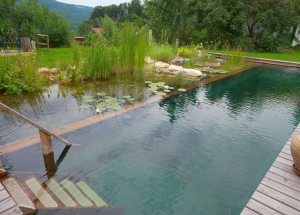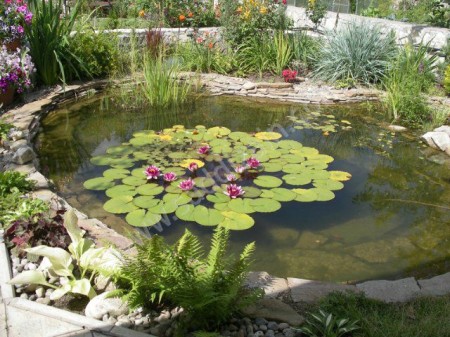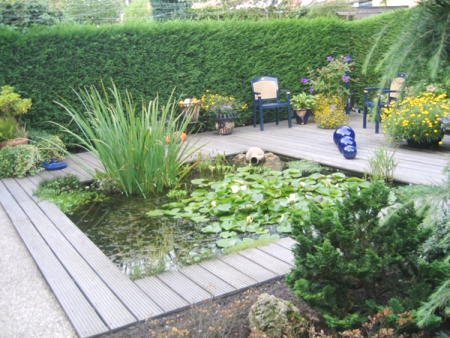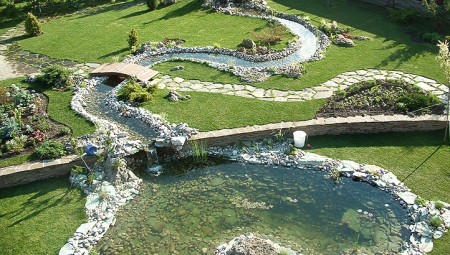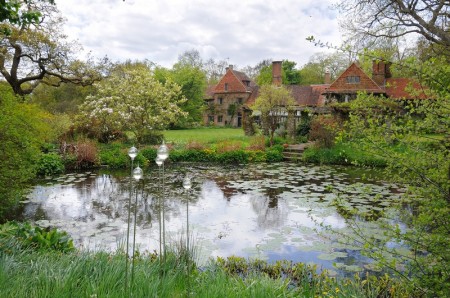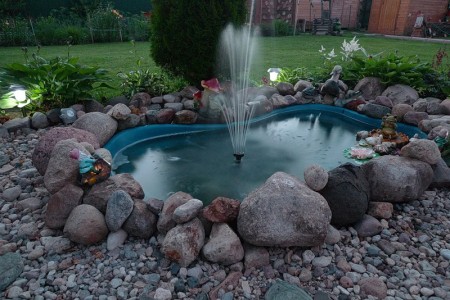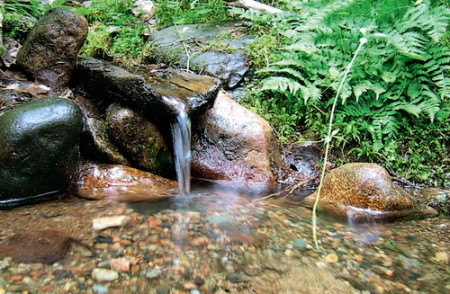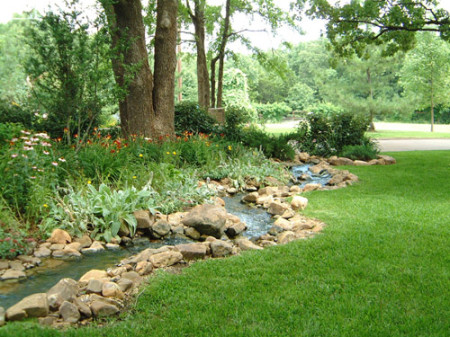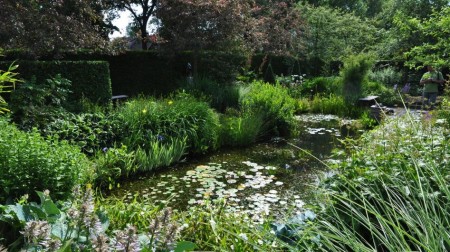The reservoir on its own site has a special appeal, it gives coolness and freshness to hot summer days. Water has the property to soothe, improve mood and restore energy and well-being.
There are many types of artificial reservoirs, which one to choose - depends on the site - its size, style of decoration, and, of course, on the personal tastes and preferences of the owner.
A smoothly flowing stream, a picturesque waterfall or fountain creates the effect of constant movement. These types of water bodies are very popular with active and self-confident people. For those who live in a calm and measured rhythm, a quiet pond, a swimming pool or even a small cozy bog is more suitable. Each pond must have a "place" in the suburban area, that is, ideally fit into the landscape and do not interfere. Where to place the reservoir, how to choose the right place for the most common types of artificial reservoirs, read below.
Content
Forms of artificial reservoirs
In general, all reservoirs for summer cottages can be divided into two main types: formal and ponds with free borders. The first is often performed in the form of simple geometric figures: a rectangle of a square, a circle, an oval, and so on.
Sometimes these ponds are given more complex contours - a polygon or an ellipse. When the shore line has simple outlines, it is much easier to arrange by planting plants, bushes or trees on the shore. Dacha pond simple and neat form easier to fit into almost any landscape, as its size is easy to calculate.
As for water bodies with free borders, they are more suitable for large areas, because the places are pretty decent. The coastline of this reservoir looks more natural, but it must necessarily be decorated with plants.
To make such a pond is necessary in the same style as the site as a whole - it should harmoniously fit into the design.
Types of reservoirs for the suburban area
dynamic water bodies
To such, in the first place, you can include waterfalls. They are placed on terrain with an uneven terrain, which has different heights. Differences create, using beautiful stones, which are laid out by ledges. A container with water placed at the bottom of the waterfall is securely fixed in the ground, and, if necessary, drainage is made. The height of the waterfall, its size and shape, each owner determines himself, based on personal preferences and financial possibilities.

It can be as a modest construction with small drops and a thin flowing trickle of water, and a noisy boiling stream. In the latter case, do not forget about the radius of dispersion of the spray, especially in windy weather.
Cascade pond.
More complex construction, is a beautiful ensemble, consisting of several waterfalls that look very harmonious, and perfectly fit into the garden landscape.

To make such a construction, you need a solid experience and considerable financial investments - time, labor and materials need a lot. It is necessary to correctly calculate the interaction of water flows, and their reflection from different surfaces. The combination of flat areas and steep cliffs creates an indescribable effect of quiet murmur and falling water.
Spring. Another type of reservoir, in which water is constantly moving. A small bias is necessary to ensure the dynamics of the water. It can be natural and artificial - for this, the depth of the bed of the spring, starting from the source, is gradually increased.

It is also necessary to ensure the drainage of accumulating water - it is easiest to put water "in a circle" by means of a pump back to the "source". The "source" itself can be decorated as you like - under a pile of stones, stemming from the stump, or from a beautiful jug. Decorate the channel of the garden stream each can in its own way - there are no clear rules here. You can build decorative bridges, plant the plants along the banks, install a watermill mock-up, and so on.
Fountain. This building always looks very impressive. On the water jet, changing intensity, height, direction or even color, you can look endlessly.

The fountain with illumination is especially beautiful in the evening and at night. And if you still install a system that generates bubbles in the pond, the effect will be even brighter. When choosing plants for a fountain, you need to carefully study the question - not all water vegetation can live in actively boiling water.
static waterbodies
Pond. One of the most popular and common types of artificial reservoirs. Perfect for people who prefer to relax in a calm and peaceful environment.

The quiet surface of the water surface of the pond clears thoughts and gives peace and tranquility. The pond and its banks can be decorated, for example, with decorative statues, the coast line planted with beautiful plants. Carrying out the arrangement of the reservoir at the dacha, it can be populated by frogs, fish or turtles.
The swamp. This pond with standing water is densely populated with a variety of aquatic vegetation. The swamp is different from the pond in small sizes. The main "feature" of a decorative swamp is the presence of a large amount of vegetation with a small amount of water.

The swamp is never decorated with sand or pebbles, but uses a very large amount of moisture-loving vegetation. If the suburban area is located in the lowland, where the groundwater is shallow, then creating a swamp will be quite simple - no special tricks will be necessary - the reservoir will be filled naturally, water will only need to be added in case of severe drought.
Pool. This type of reservoir performs several functions at once - aesthetic and practical. After all, to swim in the scorching heat in the pure cool water of your own summer cottage is the dream of many. The pool needs constant care, since the water in it must comply with the accepted sanitary and technical norms.

For the pool it is necessary to purchase additional equipment for filtering, circulating and heating water.
The interior decoration of the pool can be different - ceramic, PVC, mosaic, etc. Due to the variety of shapes and colors of the finishing material, it is possible to create a variety of original bowl designs. The beach is decorated with anything - decorative stone, tiles, plants in tubs, etc. Near the pond, you can do something like a beach, wearing umbrellas and sun loungers.
Basic rules and recommendations for the location of the reservoir in the suburban area
location of the pond relative to the size of the suburban area
We will make a reservation at once that allocating too much space for artificial ponds does not make sense, because even a modest trickle or small pond can improve mood, and it is much easier to equip and care for such a pond.
When choosing the size, it should be taken into account that the pond or swamp should not be less than 3m². A pond of this size will clean itself, and there will not be a need to change the water frequently. In addition, a small pond does not require large investments of forces and resources.
For owners of suburban areas with a small area (up to 100m²), a mini-pond, a small fountain or a spring is perfect. For a suburban area with a territory from 100m² to 100m², you can arrange a medium sized pond, a small waterfall, a decorative swamp or a swimming pool. As for owners of large areas (more than 1000m²), they can afford large ponds: a pond with fish, a wide stream with bridges and appropriate decoration, a solid fountain or a large family pool.
Rules for choosing a place for different types of water bodies
When choosing a site, it should be taken into account that an artificial reservoir should not occupy more than 3% of a summer residence. In small summer cottages, it is simply impossible to arrange some types of water bodies. For large areas, the ideal solution is the combination of several types of water bodies. They can be connected with each other by streams or waterfalls.
First of all, you need to make a close inspection of the site. If there is a depression or a depression, these are ideal places to create a pond or marsh. Not bad, if nearby there will be some construction - the water in the pond will be shaded at a certain time of the day. But to place a pond near the flower bed or garden is not worth it - chemicals for processing plants can get into the water along with wind or rain water. In addition, when choosing a place, the size, shape and depth of the reservoir must be taken into account.
fountain
The location of this building on the site should be treated as scrupulously as possible. Since the fountain, in fact, is not only a reservoir, but also an ornamental structure, it should be easily seen from anywhere in the country plot. The best place for the location of the fountain is in the center of the territory. Sprays of water should not create discomfort and interfere with the movement of people. If the structure is located near the house, you need to take into account its size: the larger the fountain, the farther it should be from the buildings. Do not forget about the noise of water: it should not interfere with rest.
waterfall
For a waterfall, usually choose a small slope near the house, if any.
Around the waterfall perfectly look flowerbeds, small benches, gazebos, etc. The place of rest near the waterfall should be made as convenient and cozy as possible, otherwise the very idea of creating a waterfall loses its meaning. Just as in the case of a fountain, it is necessary to take into account the noise level of water - it should not interfere with rest. But here everything depends on personal preferences.
spring
This pond does not take up much space, and perfectly fits into any landscape, whether it's a garden, a grassy lawn or a stone-laid platform. The spring is good for owners of small plots.
creek
For the creek you need a fairly large area - because the longer the channel, the more beautiful and natural the pond looks. The stream should be made at an incline, on the plain the water will flow badly and stagnate. The stream should have a small width of the channel, so as not to interfere with the movement. For large creeks arrange small bridge bridges.
ornamental swamp
The bottom of this reservoir should be well isolated. An exception is the lowland marshland. A decorative swamp will best look in a small lowland with full or partial shading by trees or shrubs, it can be of different sizes - small or large. The decorative swamp is very harmonious with other types of reservoirs that are nearby. Best of all, if this pond is located near the fence, in the middle of green spaces.
mini pond
Such decorative ponds can be located practically in any suitable place, since their size is quite small in comparison with other types of reservoirs. Do not just place a mini pond in a sunny place, for this purpose a slightly shaded area is more suitable. In the shade the water will be less blossom, and the water inhabitants feel more comfortable.
pool
Since this is one of the largest reservoirs of artificial type, it should be in an open, well sunlit place - so the water will warm up more quickly. Since the pool is designed for bathing and rest, it is better to hide it from extraneous views with the help of bushes or trees. In this case, it is necessary to forget that the deciduous plantations will strongly pollute the water. Landscape designers recommend setting up a pool in front of the house so that it can be seen from the front door.
In general, when choosing a site for an artificial reservoir, it is necessary to take into account the following nuances:
- the place should be shaded. This slows the growth of algae and the flowering of water.
- an artificial reservoir should be illuminated for at least 5 hours a day. This is a necessary condition for the normal development of aquatic vegetation and the inhabitants of the reservoir.
- deciduous plantations strongly pollute the pond, its cleaning will take a lot of time.
- for the pond is most suitable for the northern or eastern side of the site - this place is ideal for a pond and planting plants or trees.


